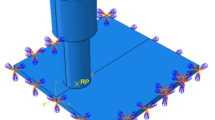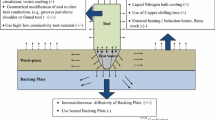Abstract
Friction stir welding (FSW) is a resource-efficient and environmental-friendly solid state joining process that allows to combine especially aluminum alloys with superior joint quality. Therefore, FSW is perfectly suitable for light-weight applications. The interaction of material, welding tool and machine during welding results in process forces which show characteristic periodic variations. The reasons for this periodicity, however, are not completely understood yet. Since the welding force feedback data can presumably be used for online process monitoring, a deeper understanding of the processes leading to the friction stir welding dynamics is necessary. To reach this goal, an approach for a systematic investigation of the friction stir welding dynamics using postulated hypotheses is presented in this work. The hypotheses combine insights from literature as well as results from own welding experiments. In the experiments two aluminum alloys, EN AW 6016 and EN AW 6111, in tempers T4 and T6 each, were friction stir welded. The welding machine, the tool as well as the welding parameters were held constant for each material. The process forces, accelerations and spindle deflection were measured for each weld and additionally the joints were inspected visually for flaws. It was shown that the height of the process forces correlates loosely with the yield strength of the materials. The frequencies occurring during welding are identified to mainly consist of the spindle rotating speed and multiples thereof. The acceleration measurements are found to be a suitable way to identify welds with irregular surfaces, i.e. they provide a method for online process monitoring regarding the weld surface quality. Combining the findings from literature and insights from the experiments, five hypotheses are developed that allow a systematic investigation of the dynamics of the friction stir welding process. Each hypothesis covers a phenomenon that can lead to dynamic effects. The hypotheses consider not only the process but the whole system of process and machine. In addition to the hypotheses, a method to prove or disprove them, where the specific effects are triggered intentionally, is presented.


















Similar content being viewed by others
References
Lakshminarayanan AK, Balasubramanian V, Elangovan K (2009) Effect of welding processes on tensile properties of AA6061 aluminium alloy joints. Int J Adv Manuf Technol 40(3–4):286–296
Thomas W, Nicholas E, Needham J, Murch M, Templesmith P, Dawes C (1991) Great Britain Patent G.B. Patent Application No. 9125978.8
Werz M, Seidenfuß M (2016) High-strength friction stir welds for joining aluminum and steel with dissimilar sheet thicknesses. In: 11th international symposium on friction stir welding, Cambridge
Mishra RS, Ma ZY (2005) Friction stir welding and processing. Mater Sci Eng R 50(1–2):1–78
Reynolds AP (2008) Flow visualization and simulation in FSW. Scripta Mater 58(5):338–342
Ji L, Zuo DW, Wang M (2016) Force response characteristics and mechanical properties of friction stir welded AA2024 sheets. Mater Sci Technol 32(18):1–7
Shahi P, Barmouz M, Asadi P (2014) Force and torque in friction stir welding. In: Givi MKB, Asadi P (eds) Advances in friction-stir welding and processing, 1st edn. Woodhead, Cambridge. https://doi.org/10.1533/9780857094551.459
Record JH, Covington JL, Nelson TW, Sorensen CD, Webb BW (2007) A look at the statistical identification of critical process parameters in friction stir welding. Weld J 86(4):97s–103s
Hattingh DG, Blignault C, van Niekerk TI, James MN (2008) Characterization of the influences of FSW tool geometry on welding forces and weld tensile strength using an instrumented tool. J Mater Process Technol 203(1–3):46–57
Zaeh MF, Gebhard P (2010) Dynamical behaviour of machine tools during friction stir welding. Prod Eng Res Dev 4(6):615–624
Qian JW, Li JL, Xiong JT, Zhang FS, Li WY, Lin X (2012) Periodic variation of torque and its relations to interfacial sticking and slipping during friction stir welding. Sci Technol Weld Join 17(4):338–341
Xiong JT, Zhang XC, Li P, Qian JW, Li JL, Zhang FS, Dong HB (2014) Characterisation of periodic variation in torque occurred in friction stir welding process. Sci Technol Weld Join 19(4):350–354
Yan JH, Sutton MA, Reynolds AP (2007) Processing and banding in AA2524 and AA2024 friction stir welding. Sci Technol Weld Join 12(5):390–401
Fonda R, Reynolds A, Feng C, Knipling K, Rowenhorst D (2013) Material flow in friction stir welds. Metal Mater Trans A 44(1):337–344
Hoßfeld M (2016) Experimentelle, analytische und numerische Untersuchungen des Rührreibschweißprozesses. Dissertation, Universität Stuttgart
Shrivastava A, Zinn M, Duffie NA, Ferrier NJ, Smith CB, Pfefferkorn FE (2015) Analysis of force transients during friction stir welding. In: 43rd Proceedings of the North American manufacturing research, vol XXX, pp 1–10
Shrivastava A, Pfefferkorn FE, Duffie NA, Ferrier NJ, Smith CB, Malukhin K, Zinn M (2015) Physics-based process model approach for detecting discontinuity during friction stir welding. Int J Adv Manuf Technol 79(1–4):605–614
Gratecap F, Girard M, Marya S, Racineux G (2012) Exploring material flow in friction stir welding: tool eccentricity and formation of banded structures. Int J Mater Form 5(2):99–107
Boldsaikhan E, Corwin E, Logar A, McGough J, Arbegast W (2009) Detecting wormholes in friction stir welds from welding feedback data. In: 42nd midwest instruction and computing symposium, Rapid City, SD
Boldsaikhan E, Burford DA, Gimenez Britos PJ (2011) Effect of plasticized material flow on the tool feedback forces during friction stir welding. In: Mishra R, Mahoney MW, Sato Y, Hovanski Y, Verma R (eds) Friction stir welding and processing VI. Wiley, Hoboken. https://doi.org/10.1002/9781118062302
Kumar U, Yadav I, Kumari S, Kumari K, Ranjan N, Kesharwani RK, Jain R, Kumar S, Pal S, Chakravarty D, Pal SK (2015) Defect identification in friction stir welding using discrete wavelet analysis. Adv Eng Softw 85:43–50
Jene T, Dobmann G, Wagner G, Eifler D (2008) Monitoring of the friction stir welding process to describe parameter effects on joint quality. Weld World 52(9/10):47–53
Moal GL, Darras F, Chartier D (2015) On the feasibility of a monitoring system for the friction stir welding process: literature review and experimental study. In: IEEE international conference on automation science and engineering (CASE), Göteborg, Schweden, pp 1576–1583
Soundararajan V, Valant M, Kovacevic R (2006) An overview of R&D work in friction stir welding at SMU. Metalurgija 12(4):275–295
Sinha P, Muthukumaran S, Sivakumar R, Mukherjee SK (2008) Condition monitoring of first mode of metal transfer in friction stir welding by image processing techniques. Int J Adv Manuf Technol 36:484–489
Sued M, Pons D (2016) Dynamic interaction between machine, tool, and substrate in bobbin friction stir welding. Int J Manuf Eng 2016:8697453. https://doi.org/10.1155/2016/8697453
Technische Universität Ilmenau and Universität Stuttgart (2007) Untersuchungen zur Übertragbarkeit der Prozessparameter auf Anlagen unterschiedlicher Bauart beim Herstellen von Tailored Blanks auf geschlossener Bahn mittels Rührreibschweißen. Forschungsvorhaben AiF-Nr. 14572 N / DVS-Nr. 05.034
Benedyk JC (2010) International temper designation systems for wrought aluminum alloys: part II-thermally treated (T Temper) aluminum alloys. Light Metal Age 68(4):16–22
Johnson GR, Cook WH (1983) A constitutive model and data for metals subjected to large strains, high strain rates and high temperatures. In: Proceedings of the 7th international symposium on ballistics, vol 21
Gebhard P (2011) Dynamisches Verhalten von Werkzeugmaschinen bei Anwendung für das Rührreibschweißen. Dissertation, Technische Universität München, München
Acknowledgements
The authors would like to thank the Ministerium für Wirtschaft, Arbeit und Wohnungsbau Baden-Württemberg, Germany for providing funding for the presented research work in scope of the program “Technologischer Ressourcenschutz”.
Author information
Authors and Affiliations
Corresponding author
Rights and permissions
About this article
Cite this article
Panzer, F., Werz, M. & Weihe, S. Experimental investigation of the friction stir welding dynamics of 6000 series aluminum alloys. Prod. Eng. Res. Devel. 12, 667–677 (2018). https://doi.org/10.1007/s11740-018-0834-z
Received:
Accepted:
Published:
Issue Date:
DOI: https://doi.org/10.1007/s11740-018-0834-z




